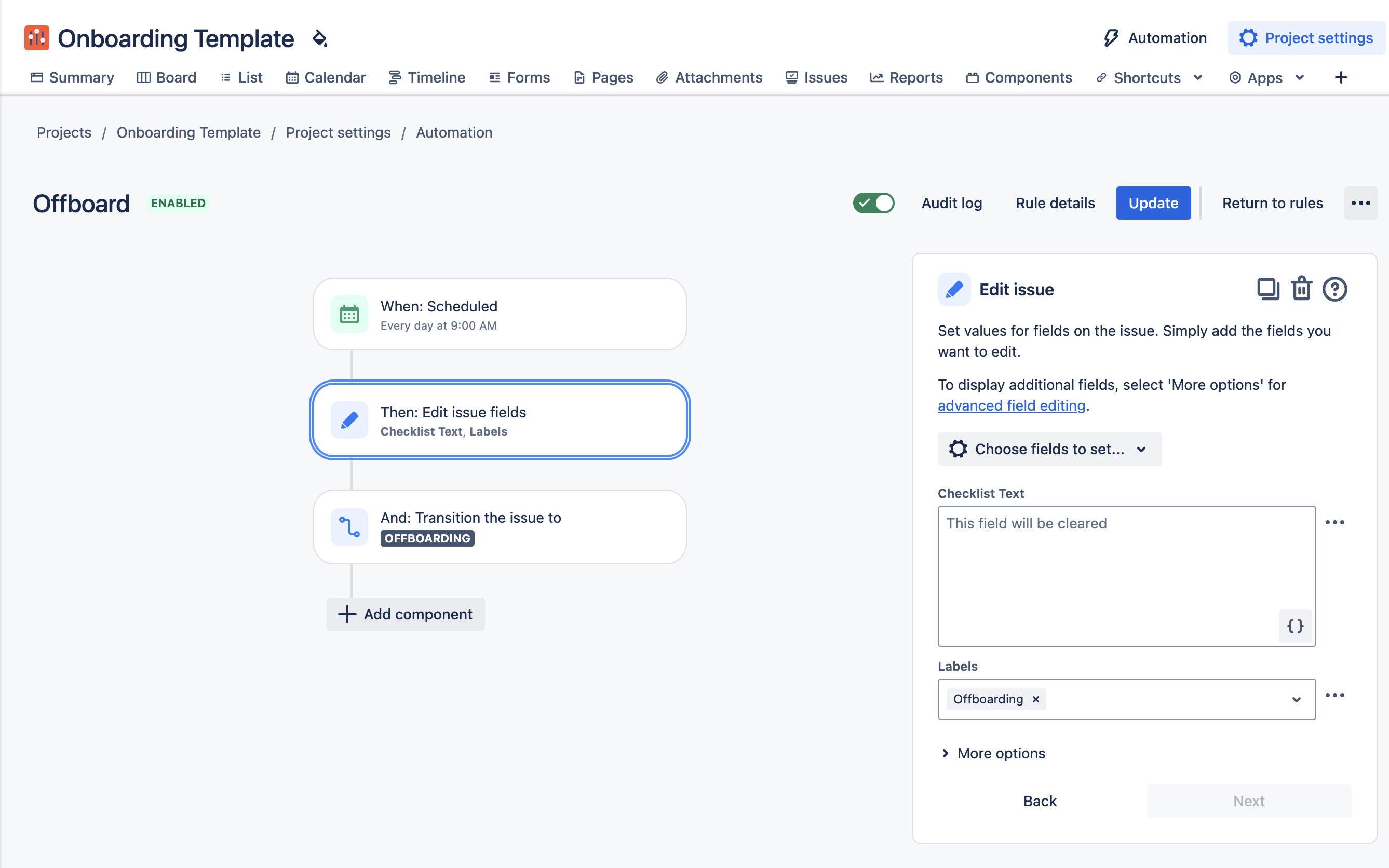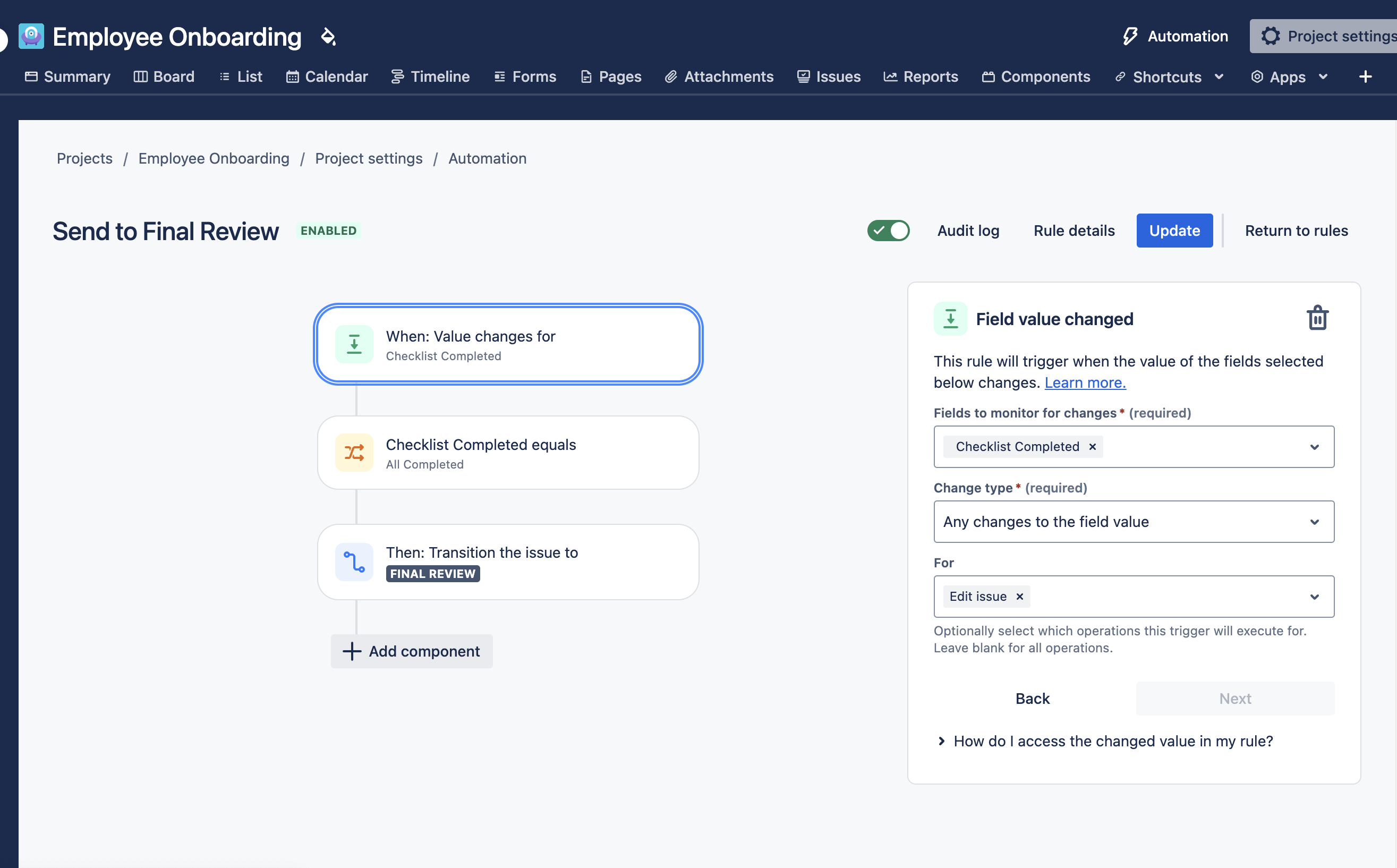Managing HR processes in Jira is a great option for small software companies who are already using Jira and who don’t have, or necessarily need, dedicated HR software. Anotherr use case demonstrated how Jira can be used to manage employee onboarding. However, employees don’t just come, they also go. Jira can be used to manage employee offboarding as well.
Workflow
We can expand our Onboarding Workflow to accommodate the entire lifecycle of an employee by adding a few more statuses:

Since members of multiple teams (HR, IT and Facilities) will be working on the issue, it’s good practice to add Workflow Conditions that only allows a member of the HR team (User is in group) to transition the issue to IN REVIEW to ONBOARDED, and from FINAL REVIEW to OFFBOARDED .
Checklist Template
As with onboarding, HR, IT and Facilities will each have multiple tasks in order to offboard the employee. However, there is not the same dependency-based order of operations. All three teams will need to prepare their tasks to be executed at the last minute. Therefore, all of the tasks can be listed in the same checklist, with separators to keep the checklist organized.

To create the Offboarding template, select Checklist from the left project nav bar. Then click Create template to create the checklist.
Tip: You can also add checklists that track the on/offboarding tasks for specific teams.
Automation Rules
Using checklists in combination with automation is a great way to streamline repeated tasks and ensure that nothing slips through the cracks. This is example will use automation to:
- Check todays date against the employee’s last day to trigger the process at the appropriate time
- Change the issue status
- Add the Offboarding checklist template
- Notify the appropriate team members
A second automation rule will change the status once the checklist is complete.
To create the first rule:
- Ensure the Save local items to Jira custom fields and Apply checklist templates from issue labels settings are enabled.
- Navigate to Project Settings > Automation (or Jira Settings > System > Automation rules).
- Click Create rule.
- Select the Scheduled trigger.
- Set the rule to run once per day at the desired hour.
- Click the Run a JQL search and execute actions for each issue in the query checkbox and the Only include issues that have changed since the last time this rule executed checkbox.
- Insert a JQL query that returns all issues that are in the ONBOARDED status have a Due date within the next two weeks due <= 2w AND status = Onboarded
- Click Save.
- Click New action
- Select Labels as the field to be updated and Offboarding as the label. Click Next.
- Click New action.
- Select Transition issue.
- Select OFFBOARDING as the destination status.
- Click Save.
- Optionally, you may want to add an additional action to set the Assignee or notify a member of the HR team.
- Name the rule and click Turn rule on.

To create the second rule:
- Navigate to Project Settings > Automation (or Jira Settings > System > Automation rules).
- Click Create rule.
- Select the Field value changed trigger.
- Select
- Checklist Completed in the Fields to monitor for changes dropdown
- Any changes to the field value in the Change type dropdown
- Edit issue in the For dropdown
- Click Save.
- Click New condition and select Issue fields condition.
- Select Checklist Completed from the Fields dropdown
- Select equals in the Condition dropdown
- Type All Completed as the Value text box.
- Click Save.
- Click Add component and select New action.
- Select Transition issue.
- Select FINAL REVIEW as the destination status and click Save.
- Optionally, you may want to add a second action to set the Assignee or notify a member of the HR team.
- Name the rule and click Turn it on.

Issue Life Cycle
- The supervisor notifies HR that an employee is going to be leaving the organization.
- HR sets the Due date field as the employee’s last day of employment.
- The automation rule is triggered when the Due date is within two weeks of the current date.
- The issue is transitioned to the OFFBOARDING status, the Offboarding checklist is automatically added to the issue and appropriate team members are notified.
- When the teams have completed the checklist items, the issue is automatically transitioned to FINAL REVIEW .
- A member of the HR team reviews the issue, sees that all onboarding tasks have been completed and transitions the issue to OFFBOARDED .
This example assumes the HR team is using a Jira Business Project. Alternatively, you could manage employee offboarding in Jira Service Management. With JSM:
- The hiring manager could submit the original request and follow progress on the portal;
- You can create multiple forms and can use pre-built form templates which have been created for offboarding.












